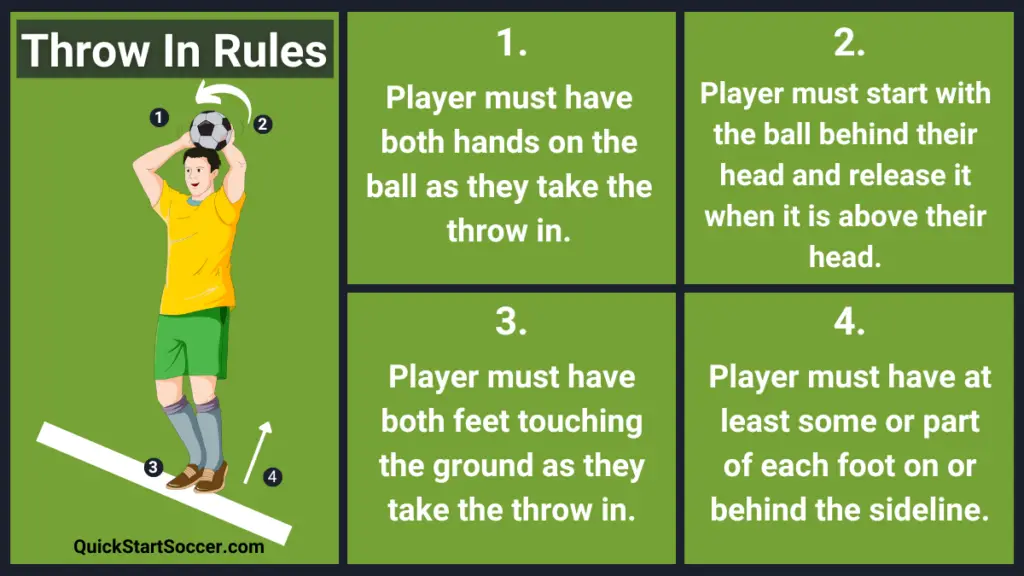Soccer Throw In | Everything You Need To Know
Of all of soccer set pieces, the throw-in is undoubtedly the most understudied and least considered of them all. Research shows that there is an average of 40-50 throw-ins in any given game, and that they occur far more often than corners, goal kicks, and free kicks.
Due to the sheer frequency of throw-ins, the importance of this set piece can not be overstated. For this reason, knowing all there is to know about soccer throw-ins is essential for aspiring players and coaches alike. In this guide, we will detail what a throw-in is, the throw-in rules, and some useful tips on how to take a good throw-in in soccer.
What Is A Throw-in In Soccer?
A throw-in in soccer is a method of restarting play after the ball exits the field over one of the two sidelines (the lines that run the length of the field on either side). A throw-in is awarded when the whole ball has crossed one of the sidelines, either along the ground or in the air. When this happens, a throw-in is awarded to the opposing team of the player who last touched the ball.
Soccer Throw-In Rules

A throw-in is the only time in a soccer game when a player other than the goalkeeper can legally and deliberately use their hands. However, there are very specific rules players must follow to take a throw-in correctly. Here are the soccer throw-in rules players must follow:
- The player taking the throw-in must stand and face the field of play with at least some or part of each foot on or behind the sideline.
- The player taking the throw-in must have both hands on the ball as they throw it in.
- The player taking the throw-in must start with the ball behind their head and release it when it is above their head using a throwing motion.
- A throw-in must take place at the point on the sideline where the ball exited the field.
- All opposition players must stand at least 2 yards from the person taking the throw-in.
- The player taking the throw-in is not allowed to touch the ball again until another player has touched it first.
- If the ball hits the ground outside the field before entering play, the throw-in is retaken.
- The thrower is not allowed to use careless or excessive force to deliberately throw the ball at an opponent.
- An opponent cannot unfairly distract or stop the thrower from throwing the ball back in. This includes standing closer to the throw-in spot than the required 2-yard minimum distance. If an opponent commits this offense, they will be given a yellow card, and an indirect free kick is awarded to the non-offending team.
- A player can throw the ball back to their own goalkeeper, but the goalkeeper is not allowed to pick the ball up in their hands upon receiving it. If the goalkeeper does pick the ball up, an indirect free kick is awarded to the opposing team at the point where the ball was handled.
What Is A Foul Throw In Soccer?
A foul throw in soccer is a throw-in that does not adhere to the specific procedure for taking a throw-in. If the following things happen, a throw-in is classed as a foul throw:
- The thrower is not facing the field of play when they take the throw-in.
- One or both of the thrower’s feet has crossed over the sideline and entered the field of play when the ball is released.
- One or both of the thrower’s feet are not touching the ground on or behind the sideline.
- The thrower does not clearly have both hands on the ball when they throw the ball in.
- The thrower does not release the ball from their hands when it is above their head.
- The throw-in is taken from a place different from where the ball originally left the field.
When a throw-in is deemed as a foul throw by the referee, a throw-in from the same spot is awarded to the other team.
Can You Score From A Throw In In Soccer?
No, you cannot score directly from a throw-in. Unlike corners and goal kicks (which you can score from), it is against the rules to score directly from a throw-in. It is worth noting, however, that if the ball touches any of the other players on the field before entering the goal, it does count.
If a player throws the ball directly into their opponent’s goal, a goal kick is awarded to the opposing team. And, if a player mistakenly throws the ball into their own goal, a corner kick is awarded to the opposing team.
Tips On How To Take A Good Throw-In

Taking a good throw-in is much more than just throwing it as far as you can. If done right, a throw-in can be a great opportunity to progress down the field and even score. Here are some useful tips on how to take a good throw-in in soccer, and how best to utilize a throw-in to your team’s advantage.
Take A Long Throw-in
Taking a long throw can really help your team advance down the field quickly. Also, if you are already in the attacking third, a long throw-in can put the ball in the penalty box and create an opportunity to score. Follow these tips to get extra distance when taking a throw-in:
- Take a big run-up to gain momentum. This momentum will help you to throw the ball further down the field.
- Angle one of your hands so it is slightly behind the ball when you throw it. This will add strength to your throw and will improve the distance you can throw the ball.
- Arch your shoulders back and then spring them forward as you release the ball.
Take A Quick Throw-in
Taking a quick throw-in can surprise your opponent and allow you to get the ball behind them before they have time to organize defensively. On your way to pick up the ball, scan the field and look for opportunities to throw the ball in quickly. Other players on your team should also be proactively looking for chances to make quick runs as soon as you pick up the ball.
Throw The Ball To A Teammate’s Feet
Throwing the ball to a player’s feet makes it much easier to control. This then gives the receiver more time to make a decision on whether they should then pass, dribble, or shoot. When throwing the ball to a player’s feet, it is easy to make a foul throw, so be careful to release the ball when it is above your head.
Have Assigned Throw-in Takers
Most professional teams have assigned throw-in takers who take the majority of their team’s throw-ins. These are usually the outside backs or numbers 2 or 3 on the soccer field. Having assigned throw-in takers helps a team establish a routine for getting the ball back in play quickly and enables them to make the most of this set piece.
Make Yourself Available For A Return Pass
A player’s job is not over once they have thrown in the ball. After throwing in the ball to a player’s feet, make yourself available for a quick return pass. Often, the throw-in taker will be unmarked as the defensive team are paying more attention to the other players on the field. By asking for a return pass after throwing in the ball, you can advance downfield yourself or at least draw a defending player away from other players on your team, which opens up a passing opportunity.
Flick It On
When the opposing team is organized well defensively, it may be difficult to throw the ball to a player’s feet. In this case, you can throw the ball to a teammate’s head so they can ‘flick it on’ passed the defender who is marking them. Combined with a well-timed run by a third player, this can be an extremely effective way to get a throw-in behind the opposing team’s defense.
More Guides
Thanks for reading! I hope you found this guide to throw-ins in soccer useful. Before you go, don’t forget to check out our articles on Soccer FAQ and Soccer Positions And Formations for more useful guides on playing and coaching soccer.

